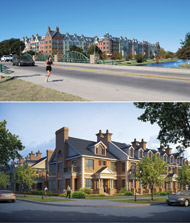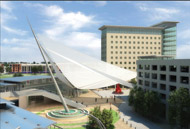| COVER STORY, JUNE 2009
DOWNTOWN’S RENAISSANCE
Texas cities are looking back to their urban cores for new development opportunities.
By Coleman Wood
By now, it cannot be denied that New Urbanism has usurped suburban development as today’s dominant residential development trend. The reasons for this are varied but the goal is universal: to bring people’s homes closer to the places where they work, shop and go for entertainment. The focus for this new development is usually on one place: downtown.
Cities all over the state of Texas have jumped on board this new trend. In general, these downtown projects can be broken down into two types: redeveloping a formerly active downtown in an effort to bring people back to the urban core or creating an official downtown where none had existed before.
The west Texas city of Lubbock is attempting to do the former. Its downtown had once been a thriving place, but now is mostly known as a nine-to-five area. According to Mike McDougal, president of locally based McDougal Properties, approximately 40,000 people work in downtown Lubbock, but at the end of the work day, the area turns into a ghost town.
A few years ago, the city of Lubbock formed a task force to study how to best solve this problem. The city formulated a master plan to redevelop its downtown and set about to find a master developer to oversee the process. McDougal Properties was the company selected.
“The task force really recognized that it was going to take someone from the private sector to bring [the redevelopment] about, instead of just waiting for the public sector to make that happen,” McDougal says.
 |
A new Wal-Mart Supercenter is one of the many retail projects constructed as part of McDougal Properties’ decade-long redevelopment of Overton Park in Lubbock, Texas.
|
|
Part of the reason McDougal Properties was chosen had to do with the company’s track record in Lubbock. Approximately 1 mile west of downtown Lubbock is the main campus of Texas Tech. The area in between these two places comprises Overton Park, a formerly blighted neighborhood that McDougal has spent the last 10 years redeveloping. The area used to be avoided by students and Lubbock residents alike. Now, Overton Park has become one of the more desirable places in the city to live and visit.
“People are moving back down there. Retailers are moving back down there. And what we will be trying to do is carry that momentum into downtown,” McDougal says.
One of the first projects McDougal is undertaking downtown, through its subsidiary, McDougal Land Company, is the redevelopment of the former 1920s-era Pioneer Hotel, which the company acquired 3 years ago (before being selected as master developer). The hotel will feature approximately 30 for-sale residential condominiums on the top eight floors of the 11-story building. The units will be custom built from 900 to 2,300 square feet, and because the infrastructure will already be in place, McDougal will be able to deliver a unit in as little as 6 weeks from the start of build out.
Portions of the third and second floors will feature office space, and the remaining space on the second floor will contain the building’s original ballrooms, which will be restored and used as event space. The first floor will contain retail space and the building’s original lobby, which will be restored as well. Pre-construction is taking place right now, with construction expected to begin in the first quarter of 2010.
Other plans for downtown redevelopment are in the very beginning stages, but some ideas that have been presented include the enhancement of the Depot Entertainment District, entertainment venues such as sports arenas and theaters, and the possible expansion of Texas Tech into downtown. For now, the primary goal of the redevelopment plan is to get downtown housing built.
“The key is getting people to live downtown. As long as people are driving 10 to 15 minutes away to their homes after work, they’re not going to be coming back downtown, regardless of what you do down there,” McDougal says.
 |
Downtown El Paso at night.
|
|
In El Paso, this line of thinking has also proven to be the impetus for its downtown redevelopment, which is being spearheaded by local development company The El Paso Project.
“The El Paso Project is a company that myself and my brother Luke came up with specifically to focus on the redevelopment of downtown El Paso, specifically by way of mixed-use residential projects,” says T.J. Karam, one of the partners with The El Paso Project.
Much like Lubbock, El Paso’s downtown today is more of a nine-to-five place than a 24-hour destination. Unlike Lubbock, El Paso is still new to New Urbanism, so Luke and T.J. Karam first have to show the city what the concept is.
This is being done with the company’s first project, known as Fst Avenue Lofts. The project, which is presently under construction, consists of a 24,000-square-foot building that will contain nine for-sale residential units and approximately 6,000 square feet of ground-floor retail space. Leases are currently being negotiated for some of the retail space, and two of the condos have been pre-sold. The company believes that interest will pick up once the project is complete this year, as many people are waiting to see what the finished product looks like.
But Fst Avenue Lofts is only the first step for The El Paso Project. The company is finalizing the contracts on three building purchases and deciding the best way to redevelop the buildings, whether it be for-sale condos, rental apartments or something else. The company doesn’t want for the project to turn into another cookie-cutter mixed-use district.
“We want downtown El Paso to be redeveloped in a way that is very organic, as opposed to something master-planned,” says Luke Karam.
In the Dallas/Fort Worth Metroplex, the past few decades have seen the suburbs move farther and farther out from the city core. Today, the expansion of the Dallas Area Rapid Transit (DART) system is causing many to look back at the city and first-ring suburbs for new development opportunities.
 |
Two projects that are planned as part of the redevelopment of downtown Irving, Texas, include a mixed-use project located on Sixth Street (top) and Delaware Townhomes (bottom). The projects are being overseen by McDougal Properties.
|
|
Before signing on to redevelop downtown Lubbock, McDougal Properties had been approached by the city of Irving to execute its downtown redevelopment master plan. “One of the keys to what Irving is doing, which is different from what is happening in Lubbock, is that the Irving project is centered around a mass transit station that is being built by DART,” McDougal says.
DART expects to open its new Green Line in late 2010. The new 28-mile long line will go from Pleasant Grove northwest through Dallas and Irving before terminating in Carrollton. In its role as a consultant and private developer, McDougal is assisting the city of Irving with its transit-oriented development (TOD) plans, while at the same time, acquiring land near the new station in anticipation of its opening.
McDougal expects to begin two projects this year, if not this summer. The first is a 100- to 150-unit multifamily rental project located immediately adjacent to the new station. The second project, which is located a couple of blocks away from the first, will consist of for-sale townhome units. Both projects have the intention of adding high-density residential space to this area in time for the transit station to open, with the expectation that this will spur even more development in the future.
“With the residential going up, we see even more possibilities for retail and commercial uses in that area,” McDougal says.
A little north of Irving on the Green Line, Carrollton is completing its own TOD plans. Once the line opens, the city will have three DART stations, including one downtown, and development plans are well under way to take advantage of this. The city of Carrollton is following the same plan of Lubbock and Irving by partnering with a private developer to master-plan its downtown redevelopment.
 |
The city of Carrollton, Texas, has partnered with High Street Residential to bring residential and mixed-use space to the downtown area, which will soon be home to a new DART station (Rendering courtesy of Jacobs).
|
|
“It’s pretty amazing the nodes that it [the Green Line] is hitting, says Art Lomenick, managing director of Trammell Crow Company and president of High Street Residential, the Trammell Crow subsidiary that is acting as master-developer for the project. Some of the major destinations on the new line include Southwestern Medical Center, Presbyterian Hospital, Baylor Medical Center and downtown Dallas itself. “So now, Carrollton, downtown especially, has a chance to become a very significant node over the next 20 years for Dallas,” he adds.
Peter Braster, the TOD manager for the city of Carrollton, mentions that the two-fold goal of the redevelopment plan is to preserve the look and feel of old downtown Carrollton, while adding a sense of vibrancy and nightlife. Downtown Carrollton personifies the early 20th century Texas downtown in its appearance, from the local retailers to the gazebo still situated at the town center. What it is short on is downtown residents and the after-hours entertainment they desire.
“What our goal became was to reinvent the main entrance into old downtown Carrollton,” Lomenick says.
The first phase of High Street Residential’s plan consists of four buildings located at the corner of Carroll and Main streets that will contain various types of multifamily residential housing, live/work units and ground-floor retail space. Landscaped courtyards will be installed, and the city itself is funding the construction of the project’s elevated parking garage, which will provide parking for residents and downtown visitors. The total cost of this first phase is expected to be $40 million. The city and High Street intend for the project to seamlessly integrate into the surrounding neighborhood.
“It’s not meant to feel like a project, especially not like a garden apartment community,” Lomenick says. “This should feel more like going to Boston, parts of Washington, D.C., the Upper East Side [of Manhattan] or SoHo. It shouldn’t feel like a typical Sun Belt apartment project.”
DART has mentioned plans to add another rail line in the future, converting the old Cotton Belt line into a commuter rail line. DFW Airport would be a major stop on this line, but travelers would have to go through Carrollton to get there — which would undoubtedly increase exposure for the city.
“You’re 20 minutes from everywhere [in Dallas/Fort Worth] in downtown Carrollton,” Braster says. “What we’re interested in is marketing that idea, because those of us in Carrollton already know it, but the rest of the world seems to have forgotten it.”
While the Carrollton project is getting started, High Street Residential is wrapping another downtown project south of Dallas in DeSoto. Like many suburbs, the city did not have a true downtown area, “They did not have a city center that they could point to and say, ‘Here’s where DeSoto lives,” says Kim McCormick, vice president of development for High Street Residential. “And that was the feel they were trying to create. That’s why it is so close to their city hall, the library, the rec center and the performing arts center.”
DeSoto Town Center comprises 136 apartments and 37,698 square feet of retail and office space. A 4.5-level parking garage also provides parking for residents, as well as visitors to the nearby city buildings. As of press, approximately half of the apartments were leased and the retail spaces will receive their certificates of occupancy this month. In the future, McCormick expects private developers to come in and expand on the concept High Street created with DeSoto Town Center.
The demand for urban mixed-use projects across the state is obvious. In areas like Dallas/Fort Worth, this product type has a long history dating back almost 20 years to Uptown in Dallas and Addison Circle in Addison. In other markets, it may be a new concept, but that is not keeping Texans from taking notice of these new projects.
“The demographic that you usually target with these projects is a group that does not want to live in the suburbs and they don’t want to be in garden apartments,” McCormick says. “They want to be able to walk out of their homes and get a cup of coffee or walk to the gym.”
With residents back downtown, it is only a matter of time before retailers and others follow. The idea of living and shopping downtown is still on its way to gaining the appeal it had decades ago, and both the public and private developers are making this a possibility.
“We believe that downtown is the heart of any city and without it, the city just can’t live,” T.J. Karam says.
©2009 France Publications, Inc. Duplication
or reproduction of this article not permitted without authorization
from France Publications, Inc. For information on reprints of
this article contact Barbara
Sherer at (630) 554-6054.
|
